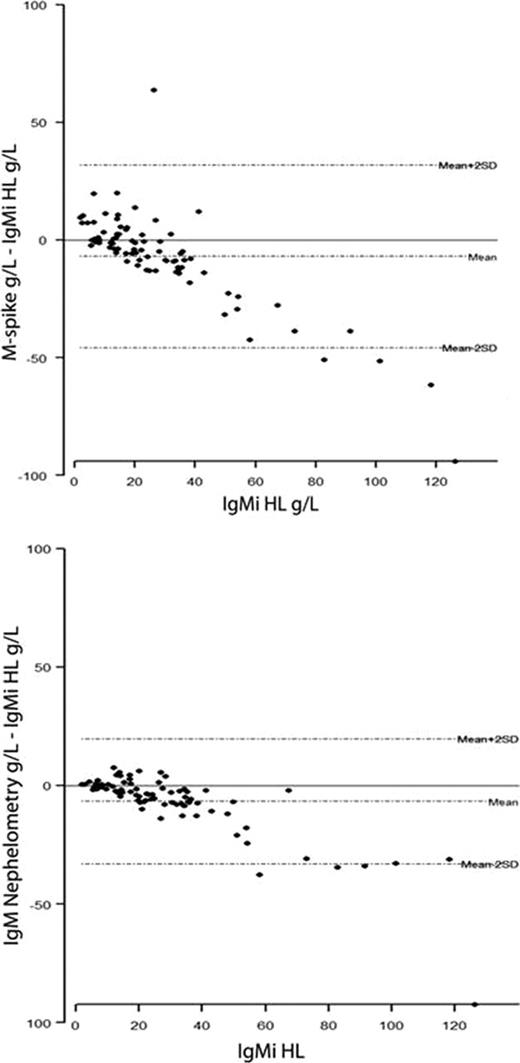Abstract
Abstract 2667
Measurement of serum M-spike is used to determine response to therapy and treatment free survival in Waldenstrom Macroglobulinemia (WM), however, its resolution on serum protein electrophoresis (SPEP) can make accurate measurement difficult. The same applies to total IgM quantification by nephelometry (IgMneph) which inherently includes monoclonal and polyclonal immunoglobulins. IgM levels by either technique do not accurately reflect tumor load or prognosis in WM. There is a need to identify new markers that reflect disease burden and correlate with patients'outcome.
Hevylite measures IgMkappa and IgMlambda, separately, and might provide true quantitative measurement of the IgM M-spike. We sought to determine whether Hevylite value can be used as a reliable marker for response to therapy in WM as compared to the M-spike measurement and to assess treatment free and overall survivals.
The study was conducted in a series of 86 WM patients [71 at diagnosis and 15 at relapse], of whom 10 patients with WM were homogeneously treated at front line in the multicentric phase 3 trial, chlorambucil versus fludarabine that included WM. All serum samples were collected prior to treatment and were kept frozen since collection. Responses included partial response (PR) or better, confirmed at 2 consecutive values. Hevylite measurements were made at The Binding Site Ltd, Birmingham, UK. A normal range was produced from normal (blood donor) sera (n=120), median (and 95%ile ranges) were; IgMkappa 0.634g/L (0.29–1.82), IgMlambda 0.42g/L (0.17–0.94), IgMkappa/IgMlambda ratio 1.6 (0.95–2.3). For ease of comparison we have studied the clonal IgM hevylite, expressed as IgMi HL and the IgM hevylite ratios expressed as the involved monoclonal immunoglobulin/uninvolved polyclonal immunoglobulin (IgM HLR).
The median age was 66.7 years, Male/Female ratio was 1.77, and 51.2 % patients had WM-ISS score 3. The median (min-max) M-spike level was 20.6 g/L (3.2–90), IgMneph was 19.4 (2.4–87), the median IgM HLR ratio was 100 (2.59–2850) and the median IgMi HL level was 21.9 (1.94–126) g/L. The IgMi HL values correlated well with the M-spike (intra class correlation (icc) coefficient = 0.48 [0.31; 0.60]) shown on the Bland-Altman plot left panel, and with the IgM neph (icc = 0.74 [0.52; 0.86]), right panel of the attached figure. The IgM HLR also correlated to the M-spike (r=0.44, p<10−5) and the IgMneph (r=0.52, p<10−5), but on a lesser extent.
The high IgMi HL level did not correlate to hemoglobin level, platelet count, beta-2 microglobulin and age, as for the IgM HLR in our study. The median IgMi HL did not vary significantly across ISS subgroups.
The response rate was 60% at 14 months and 40% were stable (including minor disease) on the 10 WM homogeneously treated. The response rates and stable diseases were 40% and 60% using IgMneph, and 50% and 50% using IgMi HL, respectively. The concordance between IgMi HL with M-spike was quite good (k=0.61, p=0.13). The median time to response was similar across the 3 IgM techniques, 10.4 months as per protocol as compared to 12.9 months with IgMneph, and 11.8 months using IgMi HL. With a median follow-up of 45.7 months [40.7; 53.9], 50% of patients had a progression in the protocol, with a median time to progression (TTP) of 25.2 months. The progression rate was 66% using IgMi HL and 50% using IgMneph. The median TTP was similar with IgMi HL and IgMneph, 23.1 months and 13.8 months (p=NS), respectively. Similar results were observed with the median time to next treatment, 4.43 months, 10.9 months and 10.9 months, respectively (p=NS).
Overall, 10 patients died, the median Overall Survival (OS) was not reached, the 5 year survival was 83.7% [73.6; 95.1]. The M-spike level by SPEP, as for the IgMi HL and IgMneph, did not predict for OS.
Hevylite is a new and reliable marker for monitoring response to therapy and to accurately monitor progression in WM, although still under investigation. The preliminary data we and other have obtained encourage to further monitor the impact of this marker in larger studies, especially clinical trials, in WM. Hevylite might become the reference technique to monitor the IgM M-spike protein in years to come.
Pietrantuono:The Bindint Site: Employment. Combat:The Binding Site: Employment. Harding:The Binding Site: Employment. Leleu:LeoPharma: Honoraria, Research Funding; Celgene: Honoraria, Research Funding; Janssen Cilag: Honoraria, Research Funding; Roche: Research Funding; Amgen: Honoraria; Novartis: Research Funding.
Author notes
Asterisk with author names denotes non-ASH members.


